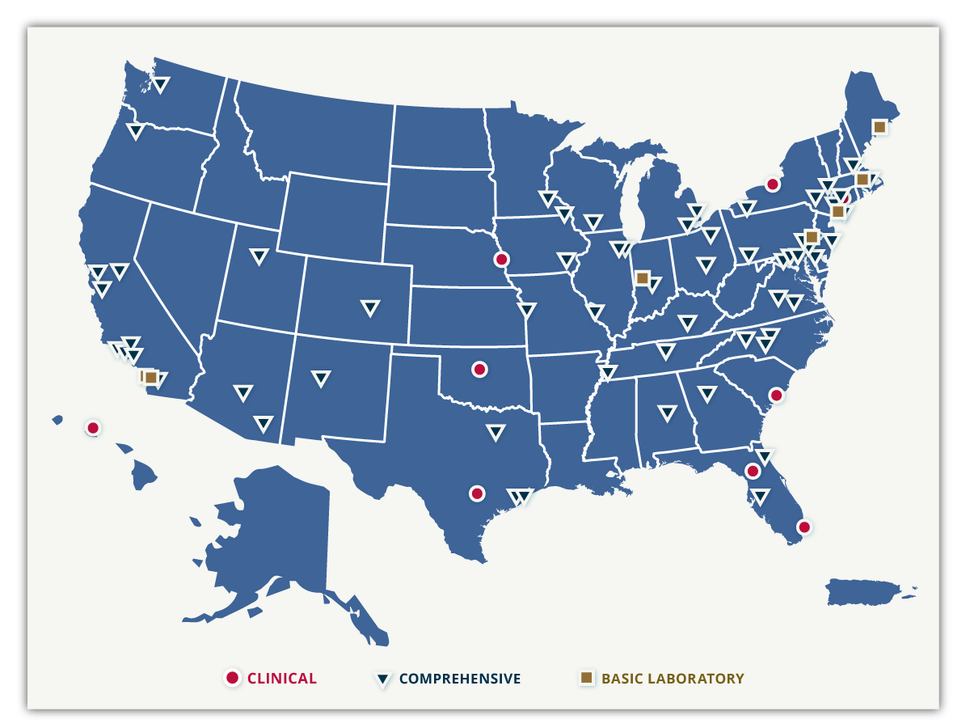NCI-Designated Cancer Centers
The NCI Cancer Centers Program was created as part of the National Cancer Act of 1971 and is one of the anchors of the nation’s cancer research effort. Through this program, NCI recognizes centers around the country that meet rigorous standards for transdisciplinary, state-of-the-art research focused on developing new and better approaches to preventing, diagnosing, and treating cancer.

Find an NCI-Designated Cancer Center
NCI-Designated Cancer Centers deliver cutting-edge cancer treatments to patients in communities across the United States. Find a center near you and learn about its specific research capabilities, programs, and initiatives.
There are 73 NCI-Designated Cancer Centers, located in 37 states and the District of Columbia, that are funded by NCI to deliver cutting-edge cancer treatments to patients. Of these 73 institutions:
- 9 are Clinical Cancer Centers, recognized for their scientific leadership, resources, and the depth and breadth of their research in basic, clinical, and/or prevention, cancer control, and population science.
- 57 are Comprehensive Cancer Centers, also recognized for their leadership and resources, in addition to demonstrating an added depth and breadth of research, as well as substantial transdisciplinary research that bridges these scientific areas.
- 7 are Basic Laboratory Cancer Centers that are primarily focused on laboratory research and often conduct preclinical translation while working collaboratively with other institutions to apply these laboratory findings to new and better treatments.
Most of the NCI-Designated Cancer Centers are affiliated with university medical centers, although several are freestanding institutions that engage only in cancer research.
At any given time, hundreds of research studies are under way at the cancer centers, ranging from basic laboratory research to clinical assessments of new treatments. Many of these studies are collaborative and may involve several cancer centers, as well as other partners in industry and the community.
Why the Cancer Centers Program Is Important to Cancer Research
The NCI-Designated Cancer Centers are recognized for their scientific leadership in laboratory and clinical research, in addition to serving their communities and the broader public by integrating training and education for biomedical researchers and health care professionals.
NCI-Designated Cancer Centers dedicate significant resources toward developing research programs, faculty, and facilities that will lead to better and innovative approaches to cancer prevention, diagnosis, and treatment. NCI supports the research infrastructure for cancer centers to advance scientific goals and foster cancer programs that draw together investigators from different disciplines.
The Impact of Cancer Centers on Cancer Care
The cancer centers develop and translate scientific knowledge from promising laboratory discoveries into new treatments for cancer patients. The centers serve their local communities with programs and services tailored to their unique needs and populations. As a result, these centers disseminate evidence-based findings to their own communities, and these programs and services can be translated to benefit similar populations around the country.
Each year, approximately 400,000 patients receive their cancer diagnoses at an NCI-Designated Cancer Center. An even larger number of patients are treated for cancer at these centers each year, and thousands of patients are enrolled in cancer clinical trials at NCI-Designated Cancer Centers. Many of the centers also provide public education and outreach programs on cancer prevention and screening, with special attention to the needs of underserved populations.
The rapid pace of discovery and the improved cancer treatments that the NCI-Designated Cancer Centers have helped pioneer over decades have increased the number of cancer survivors in the United States and improved the quality of patients’ lives immeasurably.
